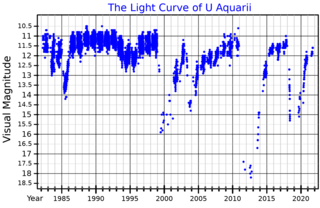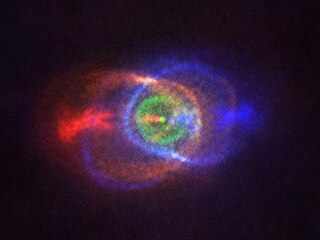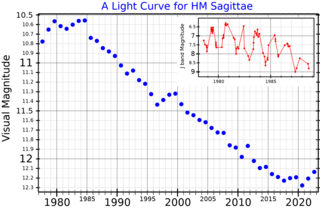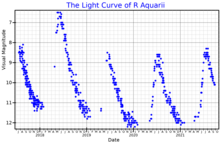
R Leporis (R Lep), sometimes called Hind's Crimson Star, is a well-known variable star in the constellation Lepus, near its border with Eridanus.

Chi Aquarii, Latinized from χ Aquarii, is the Bayer designation of a star in the equatorial constellation of Aquarius. The distance to this star, based upon parallax measurements with a 7% margin of error, is roughly 610 light-years. It is visible to the naked eye with an apparent visual magnitude of about 5.

Rho Aquarii, Latinized from ρ Aquarii, is the Bayer designation for a binary star system in the equatorial constellation of Aquarius. It is visible to the naked eye with an apparent visual magnitude of +5.34. Based upon parallax measurements, this star is at a distance of roughly 870 light-years from Earth. It is drifting closer with a radial velocity of –9 km/s. The proximity of this star to the ecliptic means it is subject to lunar occultations.
94 Aquarii is a triple star system in the equatorial constellation of Aquarius. 94 Aquarii is the Flamsteed designation. The brightest member has an apparent visual magnitude of 5.19, making it visible to the naked eye. The parallax measured by the Gaia spacecraft yields a distance estimate of around 73 light-years from Earth.
107 Aquarii is a double star in the equatorial constellation of Aquarius. 107 Aquarii is the Flamsteed designation, although it also bears the Bayer designation i2 Aquarii. The pair have an angular separation of 6.787 arcseconds. They have a combined apparent visual magnitude of +5.305, with individual magnitudes of 5.72 and 6.72. The annual parallax shift measured for the two components is 16.1 mas and 20.0 mas respectively, although with significant statistical margins of error and flags for potential unreliability of both values. This indicates the system may be at a distance of 160–200 light-years from Earth.

74 Aquarii is a triple star system in the constellation of Aquarius. 74 Aquarii is its Flamsteed designation and it also bears the variable star designation HI Aquarii. The combined apparent visual magnitude is 5.8, although it is very slightly variable, and it is located at a distance of 590 light-years from Earth.
82 Aquarii is a star in the equatorial constellation of Aquarius. 82 Aquarii is its Flamsteed designation. It has an apparent visual magnitude of 6.15, which, according to the Bortle Dark-Sky Scale, means it is a faint star that requires dark rural skies to view. The annual parallax shift of 82 Aquarii is 3.6764±0.1715 mas, which equates to a distance of roughly 890 light-years from Earth. Because this star is positioned near the ecliptic, it is subject to lunar eclipses.
Z Andromedae is a binary star system consisting of a red giant and a white dwarf. It is the prototype of a type of cataclysmic variable star known as symbiotic variable stars or simply Z Andromedae variables. The brightness of those stars vary over time, showing a quiescent, more stable phase and then an active one with a more pronounced variability and stronger brightening and/or dimming.

R Virginis is a Mira variable in the constellation Virgo. Located approximately 530 parsecs (1,700 ly) distant, it varies between magnitudes 6.1 and 12.1 over a period of approximately 146 days. Its variable nature was discovered by Karl Ludwig Harding in 1809.

U Aquarii, abbreviated U Aqr, is a variable star in the equatorial constellation of Aquarius. It is invisible to the naked eye, having an apparent visual magnitude that ranges from 10.6 down to as low as 15.9. Based on parallax measurements, the distance to this star is approximately 38 kly (12 kpc). In 1990, W. A. Lawson and associates provided a distance estimate of 43 kly (13.2 kpc) based on the assumption of a bolometric magnitude of −5. It appears to lie several kiloparsecs below the galactic plane, and thus may belong to an old stellar population.

LP Aquarii is a pulsating variable star in the constellation of Aquarius that varies between magnitudes 6.30 and 6.64. The position of the star near the ecliptic means it is subject to lunar occultations.

14 Aquarii is red giant star. 14 Aquarii is the Flamsteed designation; it also bears the variable star designation IW Aquarii. It is a semiregular variable with an amplitude of a tenth of a magnitude, and shows variations on a timescale of just one day. At its brightest, magnitude 6.44, it could be faintly visible to the naked eye under ideal observing conditions.

R Boötis is a variable star in the northern constellation of Boötes. The star's brightness varies tremendously, ranging from apparent magnitude 6.0, when it might be faintly visible to the naked eye under very good observing conditions, to 13.3, when a fairly large telescope would be required to see it. The distance to this star is approximately 2,150 light years based on parallax measurements. It is drifting closer with a radial velocity of about −58 km/s.

HU Aquarii is an eclipsing binary system approximately 620 light-years away from the Sun, forming a cataclysmic variable of AM Herculis-type. The two stars orbit each other every 2.08 hours and the ultra-short binary system includes an eclipsing white dwarf and red dwarf.

LL Pegasi is a Mira variable star surrounded by a pinwheel-shaped nebula, IRAS 23166+1655, thought to be a preplanetary nebula. It is a binary system that includes an extreme carbon star. The pair is hidden by the dust cloud ejected from the carbon star and is only visible in infrared light.

HD 65750, also known as V341 Carinae is a bright red giant star in the constellation Carina. It is surrounded by a prominent reflection nebula, known as IC 2220, nicknamed the Toby Jug Nebula.

W Aquilae is a variable star in the constellation of Aquila. It is a type of evolved star known as an S-type star. Due to its relatively close distance of 1,200 light-years and equatorial location, it is easy to observe and heavily studied.

T Leporis is a variable star in the constellation of Lepus, the Hare. It is located half a degree from ε Leporis in the sky; its distance is approximately 1,100 light years from the Solar System. It has the spectral type M6ev, and is a Mira variable — as is R Leporis, in the same constellation — whose apparent magnitude varies between +7.40 and +14.30 with a period of 368.13 days.

HD 101584 is a suspected post-common envelope binary about 1,800 to 5,900 light-years distant in the constellation of Centaurus. The system is bright at optical wavelengths with an apparent visual magnitude of about 7. The primary is either a post-AGB star, but more likely a post-RGB star. The secondary is a red dwarf or possibly a low-luminosity white dwarf, which orbits the primary every 150-200 days. The system is surrounded by a slowly rotating circumbinary disk, probably with a face-on orientation towards the solar system and a size of about 150 astronomical units.

HM Sagittae is a dusty-type symbiotic nova in the northern constellation of Sagitta. It was discovered by O. D. Dokuchaeva and colleagues in 1975 when it increased in brightness by six magnitudes. The object displays an emission line spectrum similar to a planetary nebula and was detected in the radio band in 1977. Unlike a classical nova, the optical brightness of this system did not rapidly decrease with time, although it showed some variation. It displays activity in every band of the electromagnetic spectrum from X-ray to radio.























